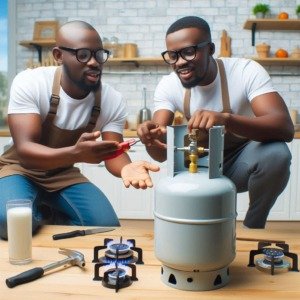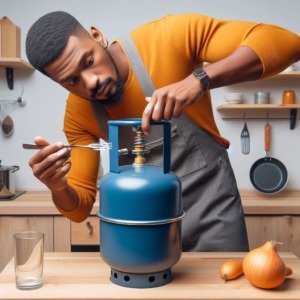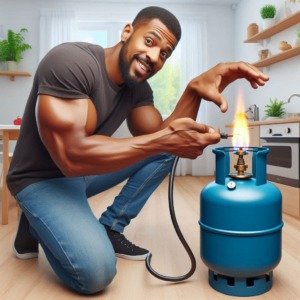How to Safely Install Gas Cylinders for Home Cooking in Nigeria
Cooking with gas cylinders has become a popular choice for many Nigerian households due to its efficiency and convenience. However, the improper handling and installation of gas cylinders can pose significant safety risks, including fire hazards and explosions. In this post, we’ll cover how to safely install a gas cylinder for home cooking in Nigeria, ensuring a safe cooking environment for you and your family.
Why Gas Cylinders are Popular in Nigerian Homes
Using gas cylinders for cooking is not only faster but also more economical in the long run. Compared to traditional firewood, kerosene, or charcoal, liquefied petroleum gas (LPG) provides clean energy that reduces indoor air pollution and is readily available across Nigeria. However, to maximize these benefits, it’s essential to follow the right steps for safe installation and use.
Steps to Safely Install Gas Cylinders for Home Cooking
1. Choose the Right Size of Gas Cylinder
The first step in safe installation is selecting the right size of gas cylinder for your household. Commonly available sizes in Nigeria range from 3kg, 5kg, 6kg, 12.5kg, to 50kg cylinders. For most households, a 12.5kg cylinder is sufficient for daily cooking, but smaller or larger sizes may be appropriate depending on your usage.
Ensure that you purchase your cylinder from reputable dealers or LPG filling stations to avoid counterfeit or defective products, which can be dangerous.
2. Ensure Proper Cylinder Placement
Proper placement of the gas cylinder is critical for safety. Always place the cylinder in a well-ventilated area, preferably outside the kitchen but close enough for the hose to reach the gas stove. A ventilated area helps prevent gas accumulation in case of leaks, reducing the risk of an explosion.
Avoid placing the gas cylinder near heat sources, electrical outlets, or direct sunlight. High temperatures can cause the gas in the cylinder to expand, leading to leaks or cylinder explosions.
3. Check for Leaks Before Installation
Before connecting the gas cylinder to your gas burner, always check for leaks. You can do this by conducting a “soapy water test.” Apply soapy water around the valve and the regulator of the cylinder. If bubbles form, it indicates that there is a gas leak. In such cases, do not use the cylinder until the leak is fixed or the cylinder is replaced.
Never attempt to ignite a stove while checking for leaks. If you suspect any leakage, turn off the cylinder immediately, remove it from the house, and seek help from professionals.
4. Use a Quality Regulator and Hose
The regulator and hose are vital components in safely connecting your gas cylinder to the stove. Ensure that you use a high-quality regulator that fits securely onto the cylinder valve. The regulator controls the flow of gas, and it should always be turned off when not in use.
When choosing a hose, opt for one that is reinforced, heat-resistant, and specifically designed for LPG use. Ensure the hose length is sufficient for proper placement but not too long that it could tangle or bend excessively. Inspect both the regulator and hose regularly for signs of wear, cracks, or damage.
5. Correctly Connect the Gas Cylinder to the Gas burner
After checking for leaks and ensuring you have the right components, you can now connect your gas cylinder to your stove. Follow these steps:
- Turn off the regulator: Ensure the gas cylinder’s regulator is in the ‘off’ position before connecting it to the stove.
- Securely attach the regulator: Attach the regulator firmly to the gas cylinder valve by pressing down or screwing it, depending on the model. Make sure it clicks or locks into place.
- Attach the hose: Connect one end of the hose to the regulator and the other to the gas stove’s inlet. Both ends should fit tightly to prevent leaks.
- Open the regulator: Once the connections are secure, turn on the regulator and listen for any hissing sound. If there’s a hissing sound, it could indicate a leak, and you should turn off the regulator immediately.
6. Keep a Fire Extinguisher or Fire Blanket Nearby
Even with the safest installation, accidents can still happen. Always keep a fire extinguisher or fire blanket nearby in your kitchen for emergencies. Make sure the extinguisher is rated for gas or kitchen fires, as not all extinguishers can handle LPG fires.
Also, educate all household members on how to use these safety tools effectively in case of a fire.
Safety Tips for Handling and Using Gas Cylinders
1. Turn Off the Regulator When Not in Use: Always turn off the gas regulator when you’re done cooking. This helps prevent accidental gas leaks or stove ignitions.
2. Store Cylinders Upright: Gas cylinders should always be stored in an upright position to avoid gas escaping from the valve.
3. Keep Away from Open Flames: When handling or changing a gas cylinder, ensure there are no open flames or ignitions nearby, such as candles, matches, or lighters.
4. Ventilate Your Kitchen: Always cook in a well-ventilated kitchen. Proper ventilation helps dissipate any accidental gas leakage and prevents dangerous build-ups.
5. Never Overfill Your Cylinder: Only use certified gas stations or suppliers that adhere to safety standards to refill your gas cylinder. Overfilled cylinders can lead to dangerous gas leaks.
6. Regular Maintenance: Periodically check the gas hose, regulator, and cylinder for any signs of damage or leaks. Replace worn-out hoses and regulators immediately.
7. Educate Family Members: Ensure everyone in your home knows how to properly handle and use gas cylinders. Children, especially, should be taught the dangers of playing with gas stoves or cylinders.
What to Do in Case of a Gas Leak
If you suspect a gas leak, do the following:
- Turn off the regulator: Immediately turn off the gas supply from the cylinder.
- Avoid flames or sparks: Do not light any matches, lighters, or operate electrical switches that may cause a spark.
- Ventilate the area: Open all windows and doors to allow gas to dissipate.
- Call a professional: Contact your gas supplier or an authorized technician to inspect the cylinder and fix the leak.
Conclusion
Cooking with a gas cylinder in your Nigerian home is convenient and efficient, but safety should always be a priority. By following the correct installation procedures and adopting safe handling practices, you can significantly reduce the risks associated with gas usage. Always use high-quality equipment, regularly check for leaks, and ensure your kitchen is well-ventilated. With these steps in place, you can enjoy the benefits of home cooking with gas while keeping your household safe.
If you found this article helpful, be sure to explore more of our insightful content on How to Register for a Waste Disposal Service in Your Nigerian Community tips. Continue reading to stay informed!









